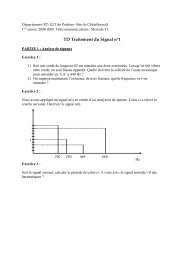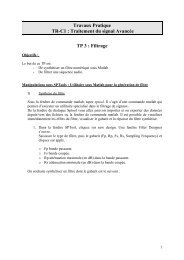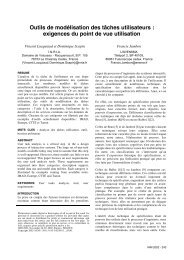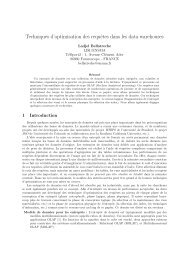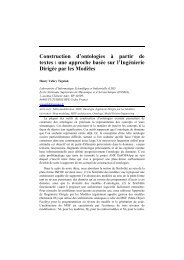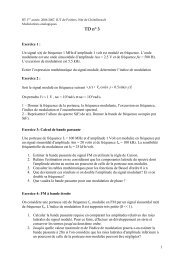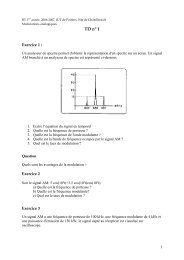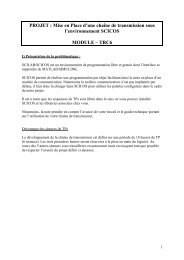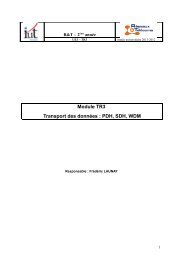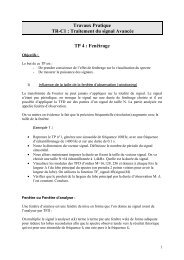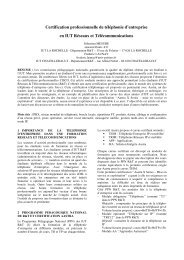Recursive subspace identification for in-flight modal ... - ResearchGate
Recursive subspace identification for in-flight modal ... - ResearchGate
Recursive subspace identification for in-flight modal ... - ResearchGate
Create successful ePaper yourself
Turn your PDF publications into a flip-book with our unique Google optimized e-Paper software.
1564 PROCEEDINGS OF ISMA2006<br />
<strong>subspace</strong> <strong>identification</strong> algorithm <strong>in</strong> [5] can be applied. In other data sets, known excitations (e.g. from the<br />
fly-by-wire control system) and unknown excitations are present. In this paper, we deal with the latter k<strong>in</strong>d<br />
of data. The recently proposed recursive <strong>subspace</strong> <strong>identification</strong> methods by Mercère et al. [12–14], which<br />
are suited <strong>for</strong> these data types, are applied to data from test <strong>flight</strong>s and the results are shown. The ability<br />
to track changes <strong>in</strong> the damp<strong>in</strong>g (slowly vary<strong>in</strong>g damp<strong>in</strong>g coefficients as well as abrupt changes) and the<br />
<strong>in</strong>fluence of the <strong>for</strong>gett<strong>in</strong>g factor are studied on simulated data.<br />
The rema<strong>in</strong>der of this paper is organized as follows. In Section 2 the <strong>identification</strong> problem is <strong>for</strong>mulated.<br />
In Section 3 <strong>subspace</strong> <strong>identification</strong> algorithms are briefly described. <strong>Recursive</strong> versions of <strong>subspace</strong> <strong>identification</strong><br />
are discussed <strong>in</strong> Section 4. Section 5 conta<strong>in</strong>s simulation examples and Section 6 applications of the<br />
methods to data from <strong>flight</strong> tests. Section 7 gives conclusions and describes our future work.<br />
2 Problem <strong>for</strong>mulation<br />
In this paper, discrete time, l<strong>in</strong>ear time-<strong>in</strong>variant models with the follow<strong>in</strong>g state space representation are<br />
considered<br />
{ [( )<br />
xk+1 = Ax k + Bu k + w k ,<br />
wp (w<br />
T<br />
with E<br />
y k = Cx k + Du k + v k ,<br />
v q v T ) ] ( ) Q S<br />
q =<br />
p S T δ<br />
R pq ≥ 0 ,<br />
where u k ∈ R m and y k ∈ R l are the observations at time <strong>in</strong>stant k of respectively the m <strong>in</strong>puts and l outputs<br />
of the process, E denotes the expected value operator and δ pq the Kronecker delta. The vector x k ∈ R n is the<br />
state vector of the process at discrete time <strong>in</strong>stant k and conta<strong>in</strong>s the numerical values of n states. v k ∈ R l<br />
and w k ∈ R n are unobserved vector signals, usually called the measurement, respectively process noise.<br />
It is assumed that they are zero mean, stationary, white noise vector sequences. The matrix pair {A, C} is<br />
assumed to be observable, which implies that all modes <strong>in</strong> the system can be observed <strong>in</strong> the output y k and<br />
can thus be identified. The matrix pair {A, [ B Q 1/2 ]} is assumed to be controllable, which <strong>in</strong> its turn<br />
implies that all modes of the system can be excited by either the determ<strong>in</strong>istic <strong>in</strong>put u k and/or the stochastic<br />
<strong>in</strong>put w k .<br />
In <strong>modal</strong> analysis applications, the <strong>modal</strong> parameters are extracted from the state space model. First, an<br />
eigenvalue decomposition is applied to the dynamical system matrix A: A = ΨΛΨ −1 , where Ψ ∈ C n×n is<br />
the eigenvector matrix and Λ ∈ C n×n is the diagonal eigenvalue matrix (assum<strong>in</strong>g A to be diagonalizable).<br />
The matrix Λ conta<strong>in</strong>s the n discrete-time eigenvalues µ i , of which the complex conjugated pairs contribute<br />
to the vibration modes. They are related to the cont<strong>in</strong>uous-time eigenvalues λ i as µ i = e λ iT s<br />
where T s is the<br />
sampl<strong>in</strong>g time (sampl<strong>in</strong>g frequency f s = 1 T s<br />
). The resonance frequencies f i and damp<strong>in</strong>g ratios ζ i can then<br />
√<br />
be found from λ i , λ ∗ i = −ζ if i ± j (1 − ζi 2) f i.<br />
In this paper the resonance frequencies f i and damp<strong>in</strong>g ratios ζ i are tracked on-l<strong>in</strong>e, given the <strong>in</strong>put and<br />
output measurements u k and y k . A <strong>subspace</strong> <strong>identification</strong> algorithm is used to obta<strong>in</strong> an <strong>in</strong>itial model,<br />
which is then updated every time a new <strong>in</strong>put-output measurement is made.<br />
3 Subspace <strong>identification</strong> <strong>for</strong> <strong>modal</strong> analysis<br />
Subspace <strong>identification</strong> algorithms have ga<strong>in</strong>ed <strong>in</strong>creas<strong>in</strong>g attention <strong>in</strong> the <strong>modal</strong> analysis community over<br />
the last few years, see <strong>for</strong> <strong>in</strong>stance [1, 3, 8, 17]. This is due to their <strong>in</strong>herent numerical robustness and their<br />
ability to deal with large numbers of <strong>in</strong>puts and outputs. In contrast to classical predictor error methods,<br />
where a costly, often nonl<strong>in</strong>ear optimization has to be per<strong>for</strong>med, <strong>subspace</strong> <strong>identification</strong> techniques derive<br />
models <strong>for</strong> l<strong>in</strong>ear systems solely by apply<strong>in</strong>g well-conditioned operations like LQ and s<strong>in</strong>gular value decompositions<br />
on block Hankel data matrices.<br />
Block Hankel matrices with <strong>in</strong>put and output data are the basic start<strong>in</strong>g blocks <strong>for</strong> <strong>subspace</strong> <strong>identification</strong>



